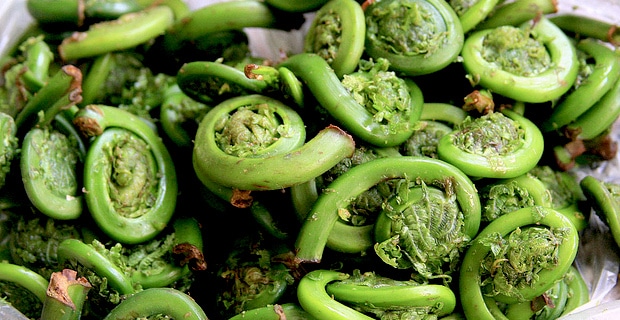
Behold the fiddlehead, the furled fronds of a fledgling fern that ring in the spring for food lovers and foragers across New England, the Great Lakes, and eastern Canada. There’s something undeniably magical about eating the wild nascent ferns, they seem like the food of Hobbits or woodland nymphs.
Found in wet areas, often along babbling rivers, streams, and brooks, hunting for fiddleheads marks the transition from winter to summer for many a forager; they are also available at farmers' markets and some specialty stores.
Fiddleheads have a unique flavor, like the crazy love child of asparagus and spinach, with some artichoke and grass thrown in for good measure. In a nutshell, they taste like spring. They are a good source of fiber, vitamin C, vitamin A, and omega-3 fatty acids.
Read more about reasons to eat seasonally
There are three main species of edible ferns in North America, but the most commonly consumed is the ostrich fern Matteucia struthiopteris. (The other two are the lady fern Athyrium filix-femina, and bracken fern Pteridium aquilinum.) If you plan to forage for them yourself, please be cautious. Not all ferns are edible, and some are toxic.
As the University of Maine reports, fiddleheads provide the opportunity for foodborne illness. In 1994 there was a large outbreak of foodborne illness that the Center for Disease Control (CDC) related to eating raw or undercooked fiddleheads. The exact cause was never figured out, but experts say that the proper handling and cooking of fiddleheads will help reduce the risk of foodborne illness. They should never be eaten raw, and the mature fronds of ferns should not be eaten as well.
So, cooking is king here. Although many of us prefer our vegetables cooked lightly, fiddleheads should be fairly walloped. To boil the little guys, add washed fiddleheads, with chaff removed, to lightly salted water and gently boil them for 15 minutes. Alternatively, you can steam them for 15 minutes.
There are many ways to cook tender little curls; think lighter flavors, so as not to overwhelm their delicate nature. Clean fiddleheads well and make sure to remove the papery coating, then boil or steam them until tender.
Once cooked, you can top them with butter, lemon, or vinegar, or give them a quick sauté with other ingredients: shallots, a little garlic, or browned butter. Yum. Or make a savory tart, serve them with eggs, toss them with pasta, chill them for a salad – think of any way in which you would use asparagus, and employ them there.
Read more about spring greens to eat before the season ends
Because of their (sadly) short season, many people like to pickle or freeze them. To freeze them clean well, blanch them in boiling water for two minutes, cool them in an ice bath, dry them thoroughly, place them in a storage container, and freeze them. When you’re ready to use, thaw in the refrigerator or cold water, cook according to the instructions above, eat, and revel in the memories of babbling brooks and spring.
Image: Dana Moos










